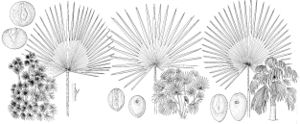Acoelorraphe
Bot. Zeitung (Berlin) 37: 148. 1879.
| Taxon | Illustrator ⠉ | |
|---|---|---|
 | Serenoa repens Livistona chinensis Acoelorraphe wrightii |
Plants moderate, clusteringed palms. Stems caespitose, erect, slender, less than 15 cm diam. Leaves: sheath fibers soft, eventually sloughing off to reveal smooth to fissured stem; petiole not split at base, armed with stout teeth, occasionally obscurely armed with minute teeth; abaxial hastula absent; adaxial hastula conspicuous, acute to acuminate; costa minute to absent; blade palmate; plication induplicate; segments lanceolate, stiff, basally connate. Inflorescences axillary within crown of leaves, paniculate, arching, longer than leaves, with 3 (–4) orders of branching; prophyll short; peduncular bracts 2, tubular, 2-keeled, long; rachillae pendulous, pubescent. Flowers bisexual, borne singly or in clusters of 2–3 along rachillae, sessile; perianth 2-seriate; sepals 3, imbricate, briefly connate, margins ciliate; petals 3, basally connate, valvate, triangular with adaxial crest; stamens 6, filaments basally connate, acuminate; anthers dorsifixed, versatile; dehiscence latrorse-introrse; pistils 3 (–4), distinct basally, glabrous; styles connate, filiform; stigmas minute. Fruits globose, stigmatic scar apical; exocarp blackish, smooth, slightly rugose when dry; mesocarp thin, fleshy; endocarp membranaceous. Seeds 1 per fruit, globose, with circular raphe; endosperm bony, homogeneous; embryo nearly basal; eophyll undivided, lanceolate. xn = 18.
Distribution
Widespread, North America, se Mexico, West Indies, Central America, and n South America (Colombia–Isla de Providencia)
Discussion
Acoelorraphe is a widespread monotypic genus. The taxa A. wrightii forma inermis Hadacč and A. wrightii var. novo-geronensis Beccari probably have no biological significance.
Recent molecular studies indicated that Serenoa is the sister genus to Acoelorraphe (N. W. Uhl et al. 1995).
Species 1.